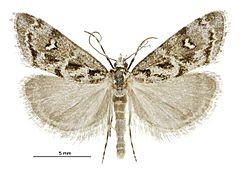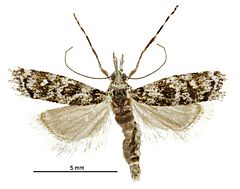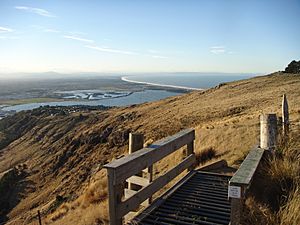Gadira petraula facts for kids
Quick facts for kids Gadira petraula |
|
|---|---|
 |
|
| Male | |
 |
|
| Female | |
| Scientific classification | |
| Kingdom: | |
| Phylum: | |
| Class: | |
| Order: | |
| Family: | |
| Genus: |
Gadira
|
| Species: |
G. petraula
|
| Binomial name | |
| Gadira petraula (Meyrick, 1882)
|
|
| Synonyms | |
|
|
The Gadira petraula is a special kind of moth that belongs to the Crambidae family. It's found only in New Zealand, which means it's endemic there. This moth is quite rare and is listed as "At Risk, Naturally Uncommon" by the Department of Conservation. Sadly, big earthquakes in 2010 and 2011 in Christchurch destroyed a lot of the places where these moths live.
Contents
Naming the Gadira Petraula
This moth was first described by a scientist named Edward Meyrick in 1882. He found specimens on the Lyttleton Hills. He first named it Scenoploca petraula.
Later, in 1883, Meyrick gave a much more detailed description of the species. Another scientist, George Hudson, also wrote about and drew this moth in his 1928 book. In 1973, David Edward Gaskin moved this moth into the genus Gadira. The main specimen used to describe the species is kept at the Natural History Museum, London.
What Does This Moth Look Like?
Scientists have described both the young moths (larvae) and the adult moths.
Larvae
The larvae of this moth are described as being:
- Moderately stout (a bit thick)
- Cylindrical (tube-shaped)
- Wrinkled
- Very sluggish (slow-moving)
- Dark greyish-brown on their back
- Much lighter on their sides
- They have tiny, dark, hard-to-see spots
- Their head is brownish
Adult Moths
The adult moths look different depending on if they are male or female.
The male moths have a wingspan of a little over 5/8 of an inch. Their front wings are somewhat long and triangular. They are white with blackish-grey patterns and a slight yellowish tint. They have a patch near the base of the wing and a wide curved band. There's also a large, irregular patch with a clear white spot in the middle. A noticeable black patch is near the wing tip. There are also two wavy blackish lines and a series of black dots along the edge. The back wings are light grey.
The female moths are smaller, with a wingspan of about 1/2 inch. Their front wings are very narrow and oblong. Their back wings are shorter and more rounded. The patterns on the female's wings are similar to the male's but are more crowded and harder to see.
Gadira petraula moths look very similar to another moth called Gadira leucophthalma. However, G. petraula is a bit smaller. Also, the front wings of G. petraula have a grey and black pattern. The other species has a more whitish-grey pattern. A key difference is that the female G. petraula has short wings and cannot fly.
Where Do These Moths Live?
This moth is found only in New Zealand. It is known to live only in the Mid Canterbury area. There were some old records of this moth being found on Stephens Island or in Australia. However, these were mistakes or due to specimens being moved by collectors.
Life Cycle and Habits
The adult female Gadira petraula moth cannot fly. The male moths have been seen flying in March. Adults have also been found from mid-October to December. The exact time depends on how high up in the mountains they live. Scientists think there might be several generations of these moths born throughout the year.
What Do They Eat and Where Do They Live?
The young moths, or larvae, of G. petraula eat moss or lichens. These plants grow on volcanic rocks. The larvae live in small cracks in the rocks. They build a shelter out of silk and come out of it to feed. These moths prefer to live in rocky areas near the coast, in mountains, or in low alpine regions.
Conservation Status
This moth is considered "At Risk, Naturally Uncommon" by the New Zealand Threat Classification System. This means it's not common and needs protection. The places where this moth lives are in danger. This is due to cities growing bigger (urbanization).
The big earthquakes in Christchurch in 2010 and 2011 destroyed or damaged much of their habitat. Another threat is when rock climbers clean the rock faces. This can remove the moss and lichens that the larvae eat.


